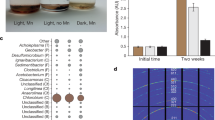Abstract
The recent discovery of stromatolites and microfossils in 3.5-Ga-old sedimentary rock formations is evidence for the existence of phototrophic prokaryotes at that time. Values of δ13C for sedimentary organic carbon strongly suggest autotrophic CO2 fixation, and the existence of large deposits of sedimentary sulfate is consistent with a photosynthesis dependent on reduced sulfur compounds for reducing power. The ancient photoautotrophs are though to have contained only one kind of reaction center with either chlorophyll a or bacteriochlorophyll a as primary electron donor and with one or more iron-sulfur centers as secondary electron acceptors. Light-harvesting pigments might have been chlorophyll a, bacteriochlorophyll a, or possibly bacteriochlorophyll c.
A new proposal is made to explain how these organisms could have survived an intense UV flux at the earth's surface in the absence of an ozone layer. Photochemically produced ferric iron was abundant in sediments, and the UV-absorption of this ferric iron would have been sufficient to shield those organisms living below the watersediment interface.
Similar content being viewed by others
References
Braterman PS, Cairns-Smith A and Sloper RW (1983) Nature 303, 163–164
Ehrenfreud M and Leibenguth J-L (1970) Bull. Soc. Chim. Fr. 2494–2505
Groves DI, Dunlop JSR and Buick R (1981) Sci Am. (Oct.) 56–65
Olson JM (1970) Science 168, 438–446
Olson JM (1978) Evolutionary Biology 11, 1–37
Olson JM (1981) BioSystems 14, 89–94
Padan E (1979) Annu. Rev. Plant Physiol 30, 27–40
Rambler MB and Margulis L (1980) Science 210, 688–640
Roberts WL, RappJr. GR and Weber J (1974) Encyclopedia of minerals New York: Van Nostrand Reinhold
Schidlowski M, Hayes JM and Kaplan IR (1983) In Schopf JW, ed. Earth's earliest biosphere, pp. 149–186. Princeton NJ: Princeton Univ. Press
Schopf JW (1974) Evolutionary Biology 7, 1–43
Schopf JW and Walter MR (1983) In Schopf JW, ed. Earth's earliest biosphere, pp. 214–239. Princeton, NJ: Princeton Univ. Press
Trendall AF and Blockley JG (1970) Bull. Geol. Surv. West Aust. 119
Veizer J (1983) In Schopf JW, ed. Earth's earliest biosphere, pp. 240–259. Princeton, NJ: Princeton Univ. Press
Walker JCG, Klein C, Schidlowski M, Schopf JW, Stevenson DJ and Walter MR (1983) In Schopf JW, ed. Earth's earliest biosphere, pp. 260–290. Princeton, NJ: Princeton Univ. Press
Walsh MM and Lowe DR (1985) Nature 314, 530–532
Walter MR (1983) In Schopf JW, ed. Earth's earliest biosphere, pp. 187–213. Princeton, NJ: Princeton Univ. Press
Author information
Authors and Affiliations
Additional information
In honor of Prof. L.N.M. Duysens on the occasion of his retirement.
Rights and permissions
About this article
Cite this article
Olson, J.M., Pierson, B.K. Photosynthesis 3.5 thousand million years ago. Photosynth Res 9, 251–259 (1986). https://doi.org/10.1007/BF00029748
Received:
Issue Date:
DOI: https://doi.org/10.1007/BF00029748




